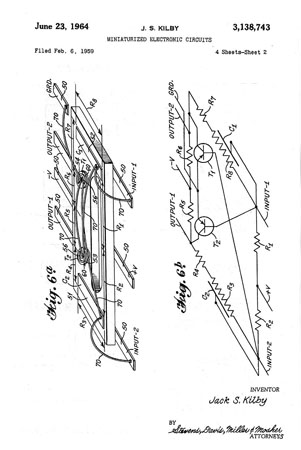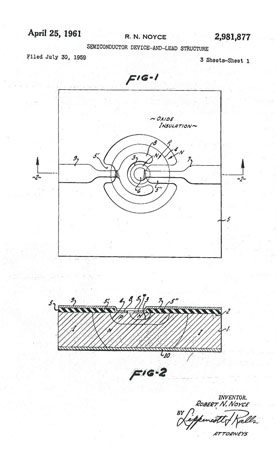5) Kilby vs. Noyce


Picture A (left) – Integrated flip-flop circuit, patented by Kilby
Picture B (right) – Planar IC, patented by Noyce
(Click to enlarge)
Picture A shows the integrated flip-flop circuit invented
by Jack Kilby, whose patent application was filed in February of 1959. It
was configured with a mesa transistor, bulk resistor, and diffusion capacitor,
connected with gold wire bondings.
Picture B shows the Planar IC invented by Robert Noyce, who filed his patent
application in July of the same year. It was composed of an oxidized film
which acted as an insulator, and interconnects formed by vapor-deposited metal.
In regards to these two patents, Kilby and Noyce fought fiercely for them.
The lawsuit case, Kilby vs. Noyce, was widely known, and it took about ten
years for them to reach the verdict.
The main point of the dispute was the method of interconnecting the components.
The patent, according to Kilby was, “For the electrical contacts, instead
of using the gold wire, other methods are also possible. For example,... to
vapor-deposit the silicon oxide film onto the semiconductor circuit wafer.
...Next, laying down the gold or other material on top of the “oxide” to form
the necessary electrical connection.” This was an extension of the first IC
he created. In response, Noyce described, “Depending on past methods, electrical
contacts...the wire must be directly connected to the 'components.' ... By
this invention, the lead wires can be adhered at the same time and with the
same method as the components themselves.” This is close to what today's ICs
have become.
Looking at just the conclusion, the final decision came down to the terminology
of “laid down” and “adhered” used in each of the patents. In 1969, the appellate
court for patent rights made the final verdict that “Kilby's didn't prove
the term 'laid down' always meant or later came to mean the same as “adhere”
in either electronic or semiconductor technologies”. This was in favor for
Noyce, but the Kilby side complained and requested to the Supreme Court for
reconsideration, only to be rejected.
Regardless, the rights of both developed ICs came to be possessed and cross-licensed
by both parties. This was due to the fact that both companies had previously
agreed to settle the trial in this way in the summer of 1966, before the final
verdict.
| To page top | To Part 2 index |